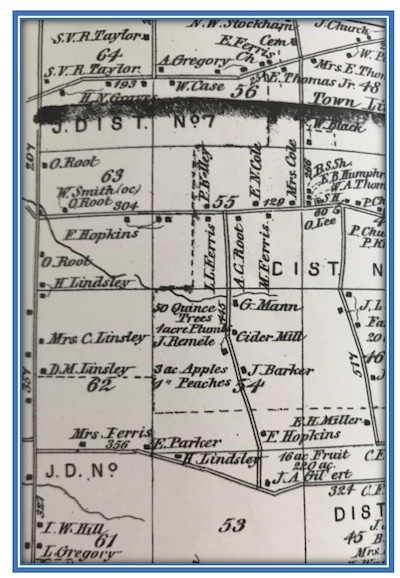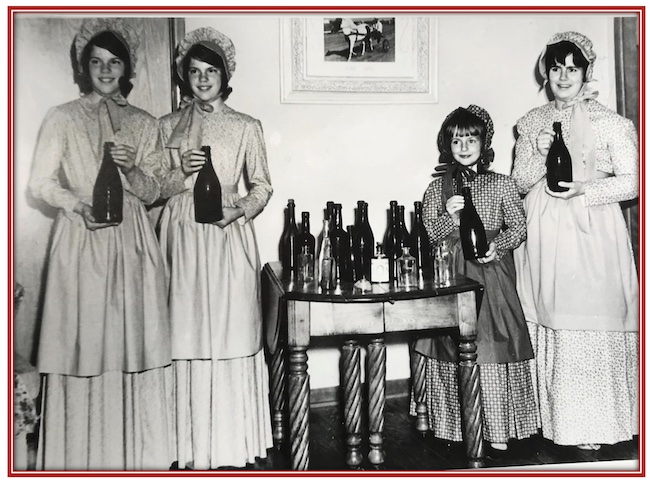Enterprising Barre farmer made his own champagne from fermented cider
Family found century-old bottles in 1967 while exploring disused cider mill on Wilkins Road
By Catherine Cooper, Orleans County Historian
Illuminating Orleans, Vol. 3, No. 12
BARRE – This photograph which is attributed to Don Cook appeared in the Journal-Register on May 15, 1968. Sharlene, Darlene, Donna and Fonda Wilkins show the unusual bottles they found on their farm on the Wilkins Road in the Town of Barre.
A previous column referenced the sulphur water found in Barre which was promoted for its alleged curative properties during the mid to late 1800s. It transpires that champagne – a much more palatable brew – was also produced in Barre around the same time.
This discovery came to light in 1967 when the Wilkins sisters were exploring a disused cider mill on their family farm on the Wilkins Road and discovered unusually shaped bottles. Using reference books from the then newly built Lee-Whedon Memorial Library in Medina, they determined that these were champagne bottles. Helen Mathes, Town of Barre Historian at the time, confirmed that a John Remele had produced cider and champagne at his cider mill on their property.
This “champagne” was a fermented cider that had been matured in vats and then bottled to produce effervescence. While the French claimed to have developed champagne in the 1600s, the English asserted their claim to the beverage as they developed the thicker glass necessary for bottling it. Regular glass cannot be used for champagne as the build-up of carbon-dioxide causes it to explode. The distinctive indent at the base of champagne bottles which allows for a more even distribution of pressure can be attributed to German ingenuity.

This map from 1875 shows that apples, peaches, plums and quince trees were cultivated in the vicinity of the Remele farm.
John Remele (also Remley/Remelee) was born in Tyringham, MA on November 25, 1827. In 1850, by the age of 23, John had established residence in Barre. He married Martha A Page, also from Massachusetts, in 1854. The majority of those who settled Orleans County were from New England.
The 1869 Directory lists John Remele of Millville in the Town of Barre as living on R.2, Lot 54, a farmer with 50 acres of land, proprietor of a cider mill and a dealer in small fruits.
John was a member of the Fruit Growers Association of Orleans County and in 1876 was a member of a committee which advocated the adoption of the 100-quart barrel as the standard barrel for apple storage.
The Remeles had four daughters, two of whom died when young: Kittie, aged 6 on Jan 3, 1869, and Nannie, aged 3, on Jan. 18, 1869. Many families at that time experienced the loss of one or more children to infectious diseases.
John died in 1901 and Martha, his wife, in 1904. They are buried in Millville Cemetery. The Remele plot and headstone also includes Jonathan L. Root and his wife Nancy, who was a half-sister of Martha’s. They both hailed from Massachusetts also and had farmed nearby in Barre.
The next owner of the Remele property was part of a new wave of farming settlers. In the early 1900s, many English people – particularly from the Norfolk area – came to settle and farm in Orleans County. John Wilkins immigrated in 1909 at the age of 24. His wife, Jessie Slater, was also from Norfolk. They are first listed at the Wilkins Road property in 1915. Ownership of the farm continued to their son, Arthur, father of the young explorers who discovered the champagne bottles.
The history of the Remele/Wilkins farm and of the Wilkins Road area reflects patterns of change in agriculture in Orleans County. Settlers first from New England and later from England quietly worked the land which is still owned by their descendants. Fruit farming predominated at first. Cabbage, pumpkins, string beans, soybeans, wheat, and corn have been produced there over the years. Farm operations have increased in size.
The Town of Barre proudly celebrated its agricultural heritage at the Sesquicentennial in 1968. The Wilkins sisters, wearing early American style dresses hand made by their mother, Mrs. Dawn Wilkins, displayed the champagne bottles used by the enterprising John Remele. Both the farm and the bottle collection are still owned by Wilkins family members.






































































